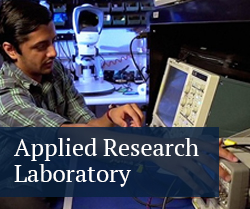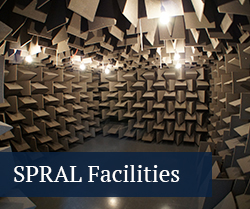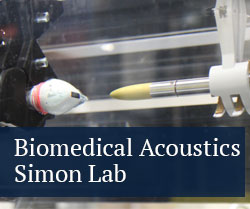
Facilities and Labs
Sound Perception & Room Acoustics Laboratory
The Sound Perception & Room Acoustics Laboratory (SPRAL) is a research laboratory housed in the Graduate Program in Acoustics at Penn State. The research team consists of both graduate and undergraduate members and focuses on topics related to room acoustic measurement techniques, virtual acoustics, spherical array processing, the subjective impression of room acoustics, neuroimaging, emotional processing of speech and music, and impact of noise upon learning and performance. Most SPRAL students are pursuing graduate degrees in acoustics, but SPRAL also offers a wide range of different backgrounds, including electrical engineering, mechanical engineering, architectural engineering, signal processing, math, computer science, and physics.
Key Faculty:
Biomedical Acoustics Simon Lab
The Biomedical Acoustics Simon Lab (BASiL) is a research laboratory in the Graduate Program in Acoustics, led by Julianna Simon, assistant professor of acoustics and biomedical engineering. The research activities in BASiL primarily focus on diagnostic and therapeutic applications of ultrasound with an emphasis on technologies that can benefit human spaceflight. Current graduate students have undergraduate degrees in acoustics, physics, and bioengineering.
Key Faculty:
Lab Features:
- VantageTM 128-channel Verasonics(R) Research Ultrasound System
- Verasonics(R) L22-14
- Philips/ATL P4-2, L7-4, and C5-2
- High Intensity Focused Ultrasound (HIFU) Transducers
- 64-mm, 1.2-MHz, f#=1 with 3.6 MHz third Harmonic
- 64-mm, 1.5 MHz, f#=0.7 with 42-mm center opening for co-axial alignment
- Fiber Optic and Capsule Hydrophones
The Sound Innovation of Metamaterials and Biomedical Acoustics (SIMBA) lab
The SIMBA lab draws principles from mechanical wave physics and mathematics to develop the next generation of wave functional materials, diagnostic and therapeutic ultrasound, and computational methods for acoustics. Yun Jing and SIMBA students strive to adopt new technologies to facilitate a host of applications such as noise control, health care, energy harvesting, and sensing.
Key Faculty:
Lab Features
- VantageTM 128-channel Verasonics(R) Research Ultrasound System
- B&K Impedance tube
- PCB shaker and accelerometer
Applied Research Laboratory
Established in 1945 at the request of the U.S. Navy, the Applied Research Laboratory (ARL) at Penn State is an integral part of the University. Originally focused on undersea weapons technology development, ARL now includes a broad research portfolio addressing the needs of various sponsors.
ARL supports national security, economic competitiveness, and quality of life through education, scientific discovery, technological demonstration, and successful transition to application.
As a Department of Defense (DoD) designated University Affiliated Research Center (UARC), ARL conducts essential research, development, and systems engineering in support of our nation’s priorities, free from conflict of interest or competition with industry.
Engineering Collaborative Research and Education Building
As you descend the Westgate Building ramp, which bridges Atherton Street below and connects the west and east sides of the Penn State University Park campus, the new Engineering Collaborative Research and Education (ECoRE) Building appears directly ahead.
- 290,000 gross square feet
- 9 active learning, general purpose classrooms
- 51,000 square feet in support of research
The building includes:
Student support offices
- Center for Engineering Outreach and Inclusion
- Engineering Advising Center
Academic unit offices, research space, and teaching labs
- Aerospace Engineering
- Architectural Engineering
- Acoustics
- Civil and Environmental Engineering





